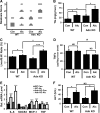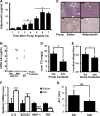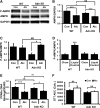Pharmacological ceramide reduction alleviates alcohol-induced steatosis and hepatomegaly in adiponectin knockout mice
- PMID: 24742988
- PMCID: PMC4042116
- DOI: 10.1152/ajpgi.00395.2013
Pharmacological ceramide reduction alleviates alcohol-induced steatosis and hepatomegaly in adiponectin knockout mice
Abstract
Hepatosteatosis, the ectopic accumulation of lipid in the liver, is one of the earliest clinical signs of alcoholic liver disease (ALD). Alcohol-dependent deregulation of liver ceramide levels as well as inhibition of AMP-activated protein kinase (AMPK) and peroxisome proliferator-activated receptor α (PPAR-α) activity are thought to contribute to hepatosteatosis development. Adiponectin can regulate lipid handling in the liver and has been shown to reduce ceramide levels and activate AMPK and PPAR-α. However, the mechanisms by which adiponectin prevents alcoholic hepatosteatosis remain incompletely characterized. To address this question, we assessed ALD progression in wild-type (WT) and adiponectin knockout (KO) mice fed an ethanol-containing liquid diet or isocaloric control diet. Adiponectin KO mice relative to WT had increased alcohol-induced hepatosteatosis and hepatomegaly, similar modest increases in serum alanine aminotransferase, and reduced liver TNF. Restoring circulating adiponectin levels using recombinant adiponectin ameliorated alcohol-induced hepatosteatosis and hepatomegaly in adiponectin KO mice. Alcohol-fed WT and adiponectin KO animals had equivalent reductions in AMPK protein and PPAR-α DNA binding activity compared with control-fed animals. No difference in P-AMPK/AMPK ratio was detected, suggesting that alcohol-dependent deregulation of AMPK and PPAR-α in the absence of adiponectin are not primary causes of the observed increase in hepatosteatosis in these animals. By contrast, alcohol treatment increased liver ceramide levels in adiponectin KO but not WT mice. Importantly, pharmacological inhibition of de novo ceramide synthesis in adiponectin KO mice abrogated alcohol-mediated increases in liver ceramides, steatosis, and hepatomegaly. These data suggest that adiponectin reduces alcohol-induced steatosis and hepatomegaly through regulation of liver ceramides, but its absence does not exacerbate alcohol-induced liver damage.
Keywords: adiponectin; alcohol; ceramide; hepatosteatosis.
Copyright © 2014 the American Physiological Society.
Figures




References
-
- Adachi Y, Bradford BU, Gao W, Bojes HK, Thurman RG. Inactivation of Kupffer cells prevents early alcohol-induced liver injury. Hepatology 20: 453–460, 1994 - PubMed
-
- Adachi Y, Moore LE, Bradford BU, Gao W, Thurman RG. Antibiotics prevent liver injury in rats following long-term exposure to ethanol. Gastroenterology 108: 218–224, 1995 - PubMed
-
- Altamirano J, Bataller R. Alcoholic liver disease: pathogenesis and new targets for therapy. Nat Rev Gastroenterol Hepatol 8: 491–501, 2011 - PubMed
-
- An L, Wang X, Cederbaum AI. Cytokines in alcoholic liver disease. Arch Toxicol 86: 1337–1348, 2012 - PubMed
Publication types
MeSH terms
Substances
Grants and funding
LinkOut - more resources
Full Text Sources
Other Literature Sources
Molecular Biology Databases
Research Materials

